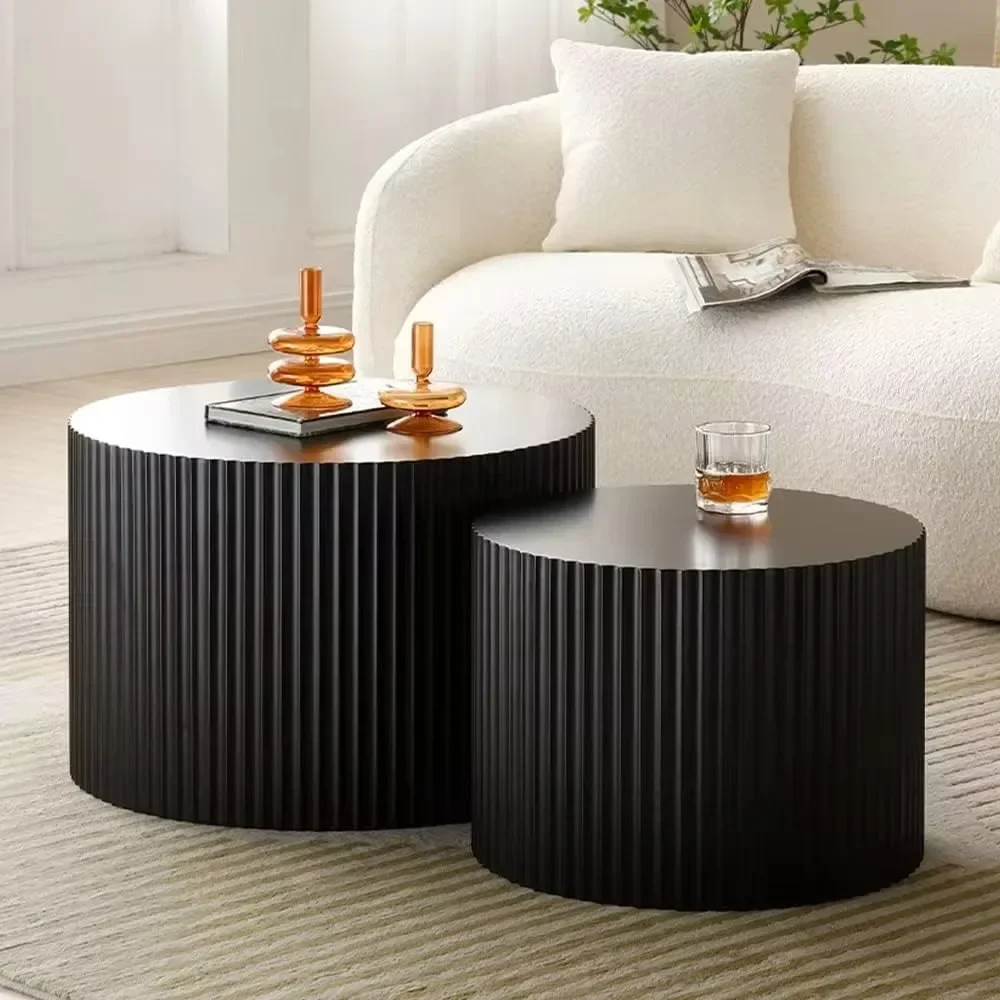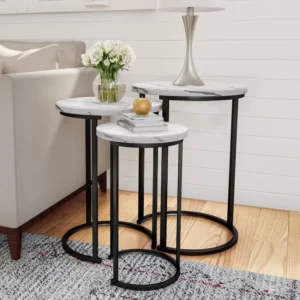The Unique Appeal of Round Coffee Tables
Round coffee tables have surged in popularity within modern interior design, and for good reason. Unlike their rectangular counterparts, circular tables create a natural flow in living spaces and offer a softer alternative to angular furniture. The gentle curves of a round table can make a room feel more inviting while facilitating easier conversation and movement around the piece.
When it comes to styling these circular beauties, however, many homeowners face unique challenges:
- The absence of corners means traditional rectangular arrangements don’t translate directly
- The 360-degree visibility requires consideration from all angles
- The limited surface area demands more thoughtful curation of items
Understanding these distinctive qualities is essential when creating an eye-catching centerpiece. The principles of intelligent black mid-century coffee tables provide valuable context for why round tables deserve special styling consideration. Their ability to soften a room’s overall aesthetic while maintaining sophistication makes them particularly versatile in various interior styles.
For those looking to incorporate this timeless shape into their homes, exploring quality mid-century modern round coffee tables can provide the perfect foundation for the styling techniques we’ll explore in this guide.
Essential Design Principles for Round Table Styling
Before diving into specific items to use in your centerpiece, it’s important to understand the fundamental design principles that make round coffee table styling successful. These guidelines will help you create arrangements that are visually appealing and proportionally balanced.
A. The Rule of Threes: Creating Visual Harmony
The human eye naturally finds arrangements of odd numbers—particularly three—more appealing and dynamic than even-numbered groupings. This psychological principle can be leveraged powerfully when styling a round coffee table:
- Group items in threes (or other odd numbers) to create natural visual interest
- Arrange these items in a loose triangular formation to guide the eye across the table
- Consider varying the visual “weight” of items while maintaining the triangle concept
For example, a tall vase might form one point of your triangle, while a medium stack of books and a small decorative object complete the arrangement. This approach creates movement and balance that feels intentional yet not overly rigid. The techniques for styling black mid-century coffee table pieces can be particularly effective when applying the rule of threes.
B. Playing with Height and Scale
Height variation is critical for creating depth and dimension in your coffee table display:
- Include at least one taller item (8-12 inches) to create a focal point
- Add medium-height elements (4-7 inches) to bridge the visual gap
- Incorporate small, low-profile items (under 4 inches) to complete the arrangement
- Use books, boxes, or platforms to elevate certain objects for more dramatic height variation
The size of your round coffee table should dictate the scale of your items—larger tables can support bigger statement pieces, while smaller tables require more delicate arrangements. For additional flexibility in creating height variation, mid-century modern nesting table sets can provide complementary surfaces at different heights.
Core Elements for a Stunning Round Table Centerpiece
Now that we’ve established the foundational principles, let’s explore the essential elements that combine to create an impressive coffee table display. Each category serves a specific purpose in building a centerpiece that’s both beautiful and functional, working together to achieve a cohesive look that enhances your entire living space.
The techniques found in guides about decorating black mid-century coffee tables can be applied to tables of any color or material using these core elements.
A. Trays: The Foundation of Your Display
Trays are particularly important for round coffee tables as they help define space and create boundaries on a boundless circular surface:
- Round trays maintain the table’s flowing aesthetic while rectangular or organic shapes create interesting contrast
- Materials like wood bring warmth, marble adds luxury, and metal introduces shine and modernity
- Size-wise, aim for a tray that covers approximately 1/2 to 2/3 of your table’s diameter
- Look for trays with low sides that corral items without blocking their view
A well-chosen tray functions as a unifying element, transforming separate decorative objects into a cohesive collection. It also makes it easy to move multiple items at once when you need to clear the table for other uses.
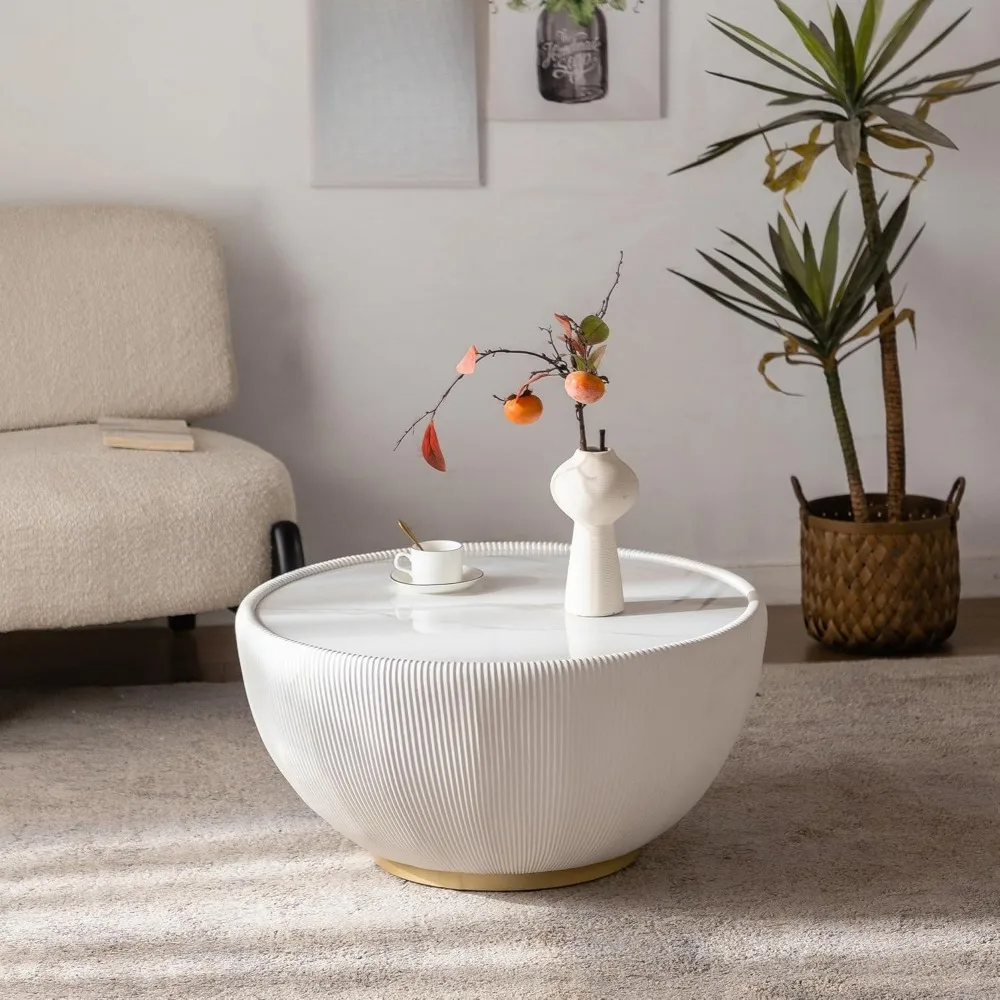
B. Books and Print Materials: Adding Height and Personality
Coffee table books do double duty: they reflect your interests while providing platforms for smaller decorative items:
- Select books with covers that complement your color scheme
- Stack 2-3 books of decreasing size for a pleasing tiered effect
- Rotate book choices seasonally or based on your current interests
- Consider art books, photography collections, or books about subjects you love
Books add substantial visual weight to an arrangement while telling visitors something about your personality. They’re also practical tools for creating height variation without the arrangement feeling contrived.
C. Natural Elements: Bringing Life to Your Centerpiece
Living elements add energy, color, and organic texture to your coffee table display:
- Small potted plants like succulents or air plants require minimal care
- Cut flowers in bud vases create elegant, changeable focal points
- Consider alternatives like branches, driftwood, or preserved botanical elements
- Match container materials to other elements in your arrangement
Natural elements soften the overall look of your centerpiece and connect your indoor space with the outdoors. The principles of square round coffee table layout can help you determine the ideal positioning for natural elements on tables of any shape.
D. Decorative Objects: Adding Character and Style
Personal objects and decorative pieces inject personality and complete your arrangement:
- Select items that vary in material, texture, and finish (ceramic, metal, wood, glass)
- Consider objects that tell a story or have personal meaning
- Choose pieces with interesting shapes that look good from multiple angles
- Mix organic, flowing forms with geometric shapes for visual contrast
The key is selecting objects that contribute to your overall design vision rather than creating clutter. Quality over quantity is essential—a few well-chosen pieces will have more impact than numerous small trinkets.
Step-by-Step Styling Process
Now that we understand the principles and elements, let’s walk through a methodical process for creating your round coffee table centerpiece. Following these steps will help you achieve a balanced, beautiful arrangement that enhances your living space.
The inspiration found in black mid-century coffee table design guides can inform your process regardless of your table’s style or color.
A. Start with a Clean Slate
Begin by completely clearing your coffee table:
- Remove all existing items, including everyday objects that may have accumulated
- Clean the table surface thoroughly to highlight its beauty
- Step back and consider your room’s layout, color scheme, and the table’s position
This fresh start gives you the opportunity to be intentional about what returns to the table surface. It also helps you see the space as a blank canvas for your creative arrangement.
B. Choose and Place Your Anchor Element
Your anchor piece sets the foundation for the entire arrangement:
- Select a substantial item like a decorative tray, a large book, or a statement bowl
- Position this anchor slightly off-center rather than directly in the middle
- Consider the direction from which the table is most commonly viewed
Your anchor should be substantial enough to ground the arrangement but not so large that it overwhelms the table. This foundational piece will determine the scale and position of everything that follows.
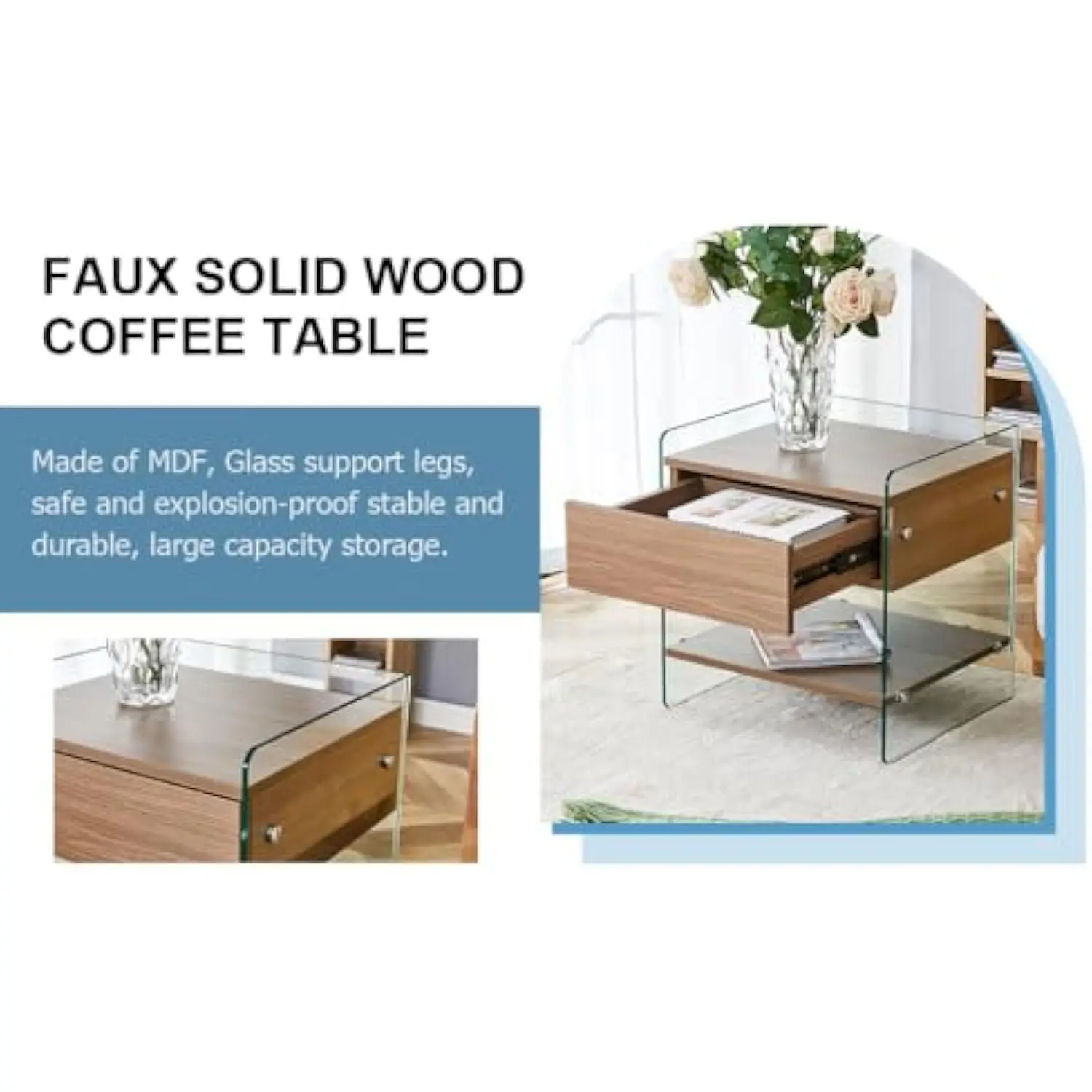
For tables with glass tops, consider how items will be visible from all angles, including through the surface. Glass top coffee tables showcase centerpieces beautifully while adding a light, airy quality to the room.
C. Build Dimension with Height Variation
Next, add your tallest element to create vertical interest:
- Choose an item approximately 12-15 inches tall for larger tables or 8-10 inches for smaller tables
- Position it near but not at the exact center of your arrangement
- Ensure it doesn’t block sightlines for conversation across the table
- Consider how it looks from all angles in the room
This vertical element draws the eye upward and creates necessary dimension. For round tables under 36 inches in diameter, keep taller items more modest in scale to maintain proportion.
D. Layer in Medium and Small Elements
With your foundation and vertical element in place, fill in with supporting pieces:
- Add medium-height objects to bridge the gap between tall and short items
- Incorporate smaller objects to complete groupings of three
- Arrange items so they form loose triangular shapes when viewed from above
- Create multiple points of interest that work together cohesively
As you add each piece, step back to assess the overall balance. Remember that medium and small elements should complement—not compete with—your anchor and tall statement piece.
E. Review and Refine
The final step involves critically evaluating your arrangement:
- Walk around the table to view it from all angles
- Sit in different seating positions to ensure the display looks good from where people will see it
- Check that nothing appears overcrowded or unbalanced
- Make subtle adjustments to spacing, angle, and positioning
- Remove any items that don’t contribute to the overall aesthetic
Don’t hesitate to edit your arrangement if it feels too busy. Sometimes removing one or two items can dramatically improve the overall impact.
Tailoring Your Centerpiece to Your Style
While the principles of good styling remain consistent, the specific items you choose should reflect your personal aesthetic and home style. Let’s explore how to adapt these guidelines to different interior design approaches.
For specific advice on glass surfaces, the principles of mastering styling glass top coffee table designs can be particularly helpful.
A. Styling by Interior Design Aesthetic
Minimalist
– Focus: Clean lines, negative space, and functional beauty
– Key elements: A single striking sculpture, one small plant, and perhaps one art book
– Materials: Matte ceramics, clear glass, light wood, or monochromatic objects
– Arrangement tip: Keep the table at least 50% empty for true minimalist appeal
Mid-Century Modern
– Focus: Organic forms meeting geometric precision
– Key elements: Teak or walnut tray, brass objects, and books about design or architecture
– Materials: Wood, brass, ceramic in earthy tones with pops of mustard, teal, or orange
– Arrangement tip: Balance curved and angular forms for authentic mid-century style
Bohemian/Eclectic
– Focus: Layered textures and global influences
– Key elements: Patterned textile as a base, plants, and globally-sourced decorative objects
– Materials: Natural fibers, handcrafted pottery, and objects with rich patinas
– Arrangement tip: Create controlled chaos through careful layering of diverse elements
Modern Farmhouse
– Focus: Rustic charm with clean modern touches
– Key elements: Wooden or whitewashed tray, ceramic pitcher with fresh or dried flowers, vintage books
– Materials: Distressed wood, galvanized metal, clear glass, and natural linens
– Arrangement tip: Balance rustic elements with clean, simple forms
Contemporary Glam
– Focus: Luxurious materials and reflective surfaces
– Key elements: Mirrored or metallic tray, crystal or art glass objects, orchid or sculptural plant
– Materials: Metal, mirror, crystal, and rich textiles like velvet
– Arrangement tip: Incorporate negative space to prevent glamorous elements from feeling cluttered
Practical Considerations for Daily Living
A beautiful coffee table arrangement should enhance your daily life, not complicate it. Let’s explore how to maintain both style and functionality in your living space.
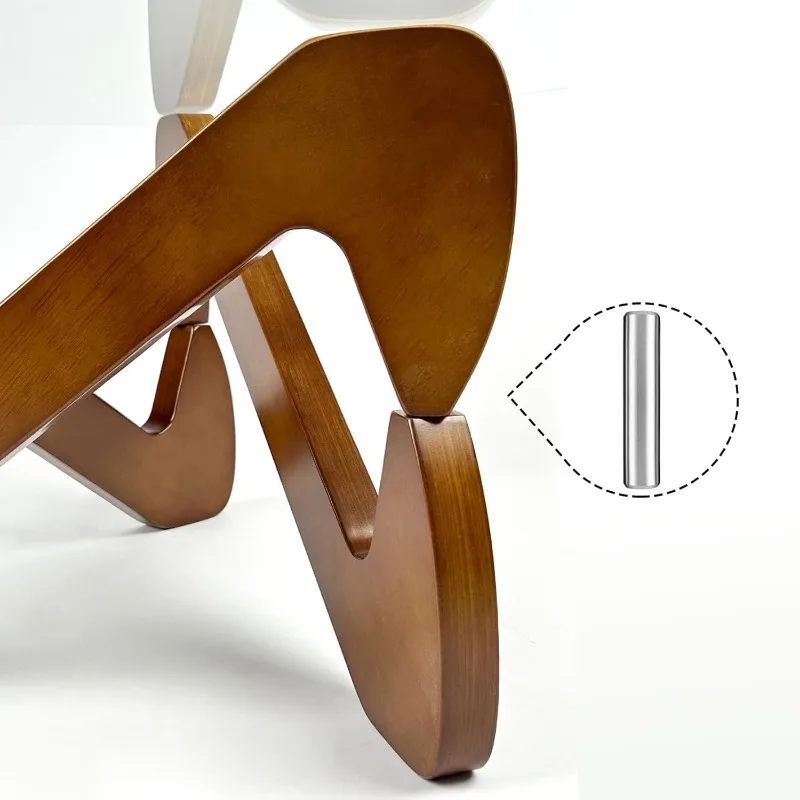
For a sophisticated foundation for your centerpiece, marble top coffee tables offer elegant durability while complementing nearly any styling approach.
A. Maintaining Functionality
Your coffee table needs to work for your lifestyle while looking beautiful:
- Reserve at least 30% of the surface for practical use (drinks, snacks, etc.)
- Incorporate decorative boxes or small trays to corral remotes and everyday items
- Consider the sight lines when people are seated—ensure arrangements don’t block conversation
- Create modular arrangements where pieces can be easily moved for temporary needs
If you entertain frequently, develop a quick “clearing strategy”—perhaps a decorative basket nearby where display items can be temporarily relocated when you need the full table surface.
B. Kid and Pet-Friendly Styling Options
Households with children or pets require special consideration:
- Choose heavier, more stable items that won’t topple easily
- Avoid delicate or sharp-edged objects that could cause injury
- Select washable materials that can handle the occasional spill
- Consider secured trays to prevent items from being knocked off
- Opt for faux plants if you have pets that might chew on real ones
- Use museum putty under valuable objects for added stability
With thoughtful selection, even family-friendly spaces can maintain stylish coffee table displays. The key is choosing durable materials and securing items appropriately.
Mid-Century Modern Solid Wood Coffee Tables, Mid-Century Modern Teak Coffee Tables
$879.95 Select options This product has multiple variants. The options may be chosen on the product pageMid-Century Modern Danish Coffee Tables, Mid-Century Modern Oval Coffee Tables, Mid-Century Modern Solid Wood Coffee Tables
$390.05 Select options This product has multiple variants. The options may be chosen on the product pageMid-Century Modern Nesting Side & End Tables, Mid-Century Modern Nesting Table Sets, Mid-Century Modern Round Side & End Tables
Price range: $239.35 through $273.06 Select options This product has multiple variants. The options may be chosen on the product pageMid-Century Modern Coffee & End Table Sets, Mid-Century Modern Coffee Table Sets, Mid-Century Modern Oval Coffee Tables
Price range: $257.48 through $331.04 Select options This product has multiple variants. The options may be chosen on the product pageMid-Century Modern Glass Top Coffee Tables, Mid-Century Modern Glass Top Side & End Tables
$460.58 Select options This product has multiple variants. The options may be chosen on the product pageMid-Century Modern Glass Top Coffee Tables, Mid-Century Modern Vintage Coffee Tables, Mid-Century Modern Vintage Side & End Tables
$725.36 Select options This product has multiple variants. The options may be chosen on the product page
VII. Refreshing Your Centerpiece
Keep your coffee table styling feeling fresh and relevant by making periodic updates:
- Swap seasonal elements quarterly to reflect changing seasons (spring blooms, summer shells, fall foliage, winter evergreens)
- Rotate books from your collection to showcase different interests throughout the year
- Change decorative objects monthly to prevent visual fatigue
- Add holiday touches subtly through small seasonal elements rather than complete overhauls
The best coffee table displays evolve over time rather than remaining static. For inspiration on various styling approaches, browse our collection of mid-century modern coffee tables that complement many different decorative styles.
VIII. Common Styling Mistakes to Avoid
Even design enthusiasts can fall into these common coffee table styling traps:
Overcrowding the Surface
A table packed with too many items creates visual chaos. Remember that negative space is an important design element—allow your selected pieces room to breathe.
Using Uniformly Sized Items
When everything is the same height, the arrangement falls flat. Ensure you have clear height variation between your tallest, medium, and shortest elements.
Selecting Inappropriately Scaled Pieces
Items that are too large make a table feel crowded, while pieces that are too small appear insignificant. Match the scale of your decorative elements to your table size.
Creating One-Dimensional Arrangements
Round tables are viewed from all sides, so arrangements that only look good from one angle are a missed opportunity. Walk around your table to ensure it’s attractive from every viewpoint.
Neglecting Functionality
A beautiful but completely impractical arrangement will quickly become frustrating. Always maintain some usable space and consider how the table functions in daily life.
IX. Styling Inspiration: Real-World Examples
Let’s explore some complete styling scenarios that bring all these principles together:
Classic Elegance on a 36-inch Table
– Foundation: Oval brass tray positioned slightly off-center
– Height: Crystal vase with simple white flowers or eucalyptus
– Medium elements: Stack of two art books with neutral covers
– Small touches: Brass object d’art and small ceramic dish for small items
– Why it works: The materials create a cohesive luxurious look while maintaining clean lines and functional space
Modern Organic on a 30-inch Table
– Foundation: Handcrafted wooden tray with organic shape
– Height: Small potted fiddle leaf fig or snake plant
– Medium elements: Two stacked coffee table books about nature or travel
– Small touches: Polished stone or geode specimen and hand-thrown ceramic vessel
– Why it works: Natural materials in varied textures create interest while the limited color palette maintains cohesion
Eclectic Collector on a 42-inch Table
– Foundation: Vintage mirrored tray positioned centrally
– Height: Unique sculptural item or architectural model
– Medium elements: Stack of vintage books with colorful spines, small globe
– Small touches: Collection of 2-3 small items from travels, like carved figurines
– Why it works: Personal items tell a story while the tray and strategic arrangement prevent it from feeling cluttered
Minimalist Calm on a 24-inch Table
– Foundation: Simple square concrete tray
– Height: Single architectural branch in a slim vase
– Medium elements: One substantial art book with a minimal cover
– Small touches: Single small sculpture in complementary material
– Why it works: Limited items with plenty of negative space create a sense of calm and intention
X. Frequently Asked Questions
How do I style a very small round coffee table (under 24 inches)?
With small tables, choose miniature versions of standard elements—perhaps a small tray, one small book, and one decorative object. Alternatively, select just one statement piece like a beautiful bowl or small plant. Remember that negative space becomes even more important on petite tables.
Do lamps work on round coffee tables?
Lamps can work on larger round tables (36+ inches) positioned slightly off-center. Choose lamps with slim profiles rather than wide shades that could overwhelm the space. For smaller tables, consider alternative lighting like small cordless table lamps or decorative candles.
How do I style glass vs. wood round coffee tables?
Glass tables benefit from objects with interesting bases since they’ll be visible from all angles. Consider placing a decorative rug or large art book underneath to add an additional layer of interest. Wood tables allow for direct placement of all items and provide a warmer foundation for styling.
What’s the best way to handle remote controls and electronics?
Decorative boxes or small trays dedicated to corralling electronic necessities keep them accessible but visually contained. Choose containers that complement your overall design—perhaps a wooden box for rustic styles or a lacquered box for more modern aesthetics.
What is the ideal height for coffee table centerpieces?
For comfortable conversation across the table, keep the tallest elements under 12-15 inches. For smaller tables, scale down proportionally. The goal is to create interest without blocking sightlines between seated guests.
By applying these principles and practical tips, you’ll create round coffee table centerpieces that enhance your living space with both beauty and functionality. Remember that the best arrangements reflect your personal style while respecting the unique qualities of your round table’s form.

